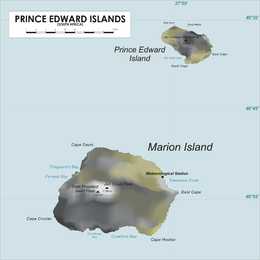Marion Island

Map of Prince Edward Islands
|
|

Orthographic projection centred on the Prince Edward Islands
|
|
| Geography | |
|---|---|
| Location | Indian Ocean |
| Coordinates | 46°46′23″S 037°51′09″E / 46.77306°S 37.85250°ECoordinates: 46°46′23″S 037°51′09″E / 46.77306°S 37.85250°E |
| Area | 335 km2 (129 sq mi) |
| Highest elevation | 1,242 m (4,075 ft) |
| Highest point | Mascarin Peak |
| Administration | |
| Demographics | |
| Population | 0 (Uninhabited – Permanent) 50 (Research Staff – Non-Permanent) |
The Prince Edward Islands are two small islands in the sub-antarctic Indian Ocean that are part of South Africa. The islands are named Marion Island (named after Marc-Joseph Marion du Fresne) and Prince Edward Island (named after Prince Edward, Duke of Kent and Strathearn).
The islands in the group have been declared Special Nature Reserves under the South African Environmental Management: Protected Areas Act, No. 57 of 2003, and activities on the islands are therefore restricted to research and conservation management. Further protection was granted when the area was declared a "Marine Protected Area" in 2013. The only human inhabitants of the islands are the staff of a meteorological and biological research station run by the South African National Antarctic Programme on Marion Island.
The islands were discovered on 4 March 1663 by Barent Barentszoon Lam of the Dutch East India Company ship Maerseveen and were named Dina (Prince Edward) and Maerseveen (Marion), but the islands were erroneously recorded to be at 41° South, and neither were found again by subsequent Dutch sailors. In January 1772, the French frigate Le Mascarin, captained by Marc-Joseph Marion du Fresne, visited the islands and spent five days trying to land, thinking they had found Antarctica (then not yet proven to exist). Marion named the islands Terre de l'Espérance (Marion) and Ile de la Caverne (Pr. Edward). After failing to land, Le Mascarin continued eastward, discovering the Crozet Islands and landing at New Zealand, where Marion du Fresne and some of his crew were killed by natives.
Julien Crozet, navigator and second in command of Le Mascarin, survived the disaster, and happened to meet James Cook at Cape Town in 1776, at the onset of Cook's third voyage. Crozet shared the charts of his ill-fated expedition, and as Cook sailed from Cape Town, he passed the islands on 13 December, but was unable to attempt a landing due to bad weather. Cook named the islands after Prince Edward, the fourth son of King George III; and though he is also often credited with naming the larger island Marion, after Captain Marion, this name was adopted by sealers and whalers who later hunted the area, to distinguish the two islands.
...
Wikipedia
